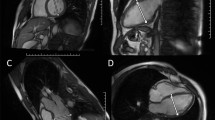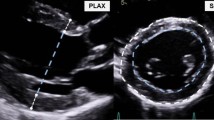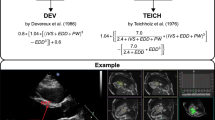Abstract
Aims: This study was designed to assess the changes in left ventricular mass (LVM) in hypertensive patients with left ventricular hypertrophy under drug therapy with once-daily slow-release diltiazem. Magnetic resonance imaging (MRI) was used for this purpose because of its higher reproducibility than M-mode or two- dimensional echocardiography. Methods: Patients suffering from essential hypertension were included if their baseline LVM index (LVMI) was ⩾105g/m2 in male or ⩾85 g/m2 in female patients, ie, equal or higher to the median values observed in hypertensive patients in our institution. MRI consisted in a true short-axis, electrocardiogram (ECG) gated spin-echo slice acquisition at baseline, after 3 and 6 months of therapy (M0, M3, and M6). Data were stored on magnetic tapes and read subsequently under blind conditions and the control of an external auditor. Results: Thirty-five patients were included. Of these, 14 patients (40%) were not previously treated. Inter- and intra-observer variability for LVMI measurement were 5.6 ± 4.3% and 2.1 ± 3.0%, respectively. Mean baseline LVMI was 110 ± 16 g/m2 in male and 96 ± 16 g/m2 in female patients. It decreased by 3.6% at M3 (P = 0.05) and by 6.0% at M6 (P = 0.02). A trend towards a greater LVMI reduction was observed in previously untreated patients. Conclusion: This study confirms that MRI is a reproducible technique for the measurement of LVM. It demonstrates a significant reduction in LVMI as early as the 3rd month of therapy in hypertensive patients treated with once-daily sustained release (SR) diltiazem, although baseline LVMI in the majority of participating patients was only moderately increased.
This is a preview of subscription content, access via your institution
Access options
Subscribe to this journal
Receive 12 digital issues and online access to articles
$119.00 per year
only $9.92 per issue
Buy this article
- Purchase on Springer Link
- Instant access to full article PDF
Prices may be subject to local taxes which are calculated during checkout
Similar content being viewed by others
Author information
Authors and Affiliations
Rights and permissions
About this article
Cite this article
Roul, G., Germain, P., Plan, D. et al. Diltiazem slow-release and left ventricular hypertrophy: a volumetric approach of left ventricular mass using magnetic resonance imaging. J Hum Hypertens 11, 379–385 (1997). https://doi.org/10.1038/sj.jhh.1000455
Received:
Accepted:
Issue Date:
DOI: https://doi.org/10.1038/sj.jhh.1000455



